The Secrets of Port Arthur

Historically speaking, let’s leave that microscope in the drawer, shall we?
Lately, I’ve had a major realization of just how many people aren’t interested in the truth of a situation, past or present. Times change. Some cultures adapt and others do not. The one thing that doesn’t seem to change, however, is the inclination to change the cover story of a distasteful situation. Whether we are talking textbooks or personal biographies, the tendency to sugarcoat is rampant—and humans have been doing it for centuries. A visit to the famous former prison colony in Port Arthur, Tasmania and a look at its history reveal some stark truths about humanity.
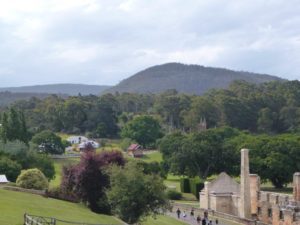
View over Port Arthur
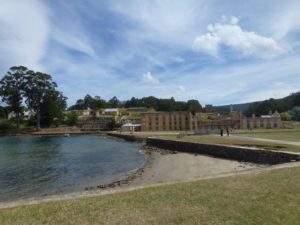
View of the convict buildings at Port Arthur
I know I’m not alone in admitting I had forgotten that Britain was transporting its convicts to the American colonies for seventy years prior to changing the destination to New South Wales. When I first began to learn about the convict history of Australia, I was fascinated. Of course I had learned about “transportation” to the New World from Great Britain in American history books, but it is different to walk in the actual footsteps of these unfortunate (if sometimes evil) men and women. American history books do not expand at length on the fact that from 1718-1775 over 54,000 British convicts were sent to what is now the United States. Even Thomas Jefferson downplayed this in 1786 claiming the number was less than 2000. Apparently he was more talented with words than with numbers.
Prior to moving to Australia in 2011, I visited several historical sites dedicated to the story of the convicts in the First Fleet and the environment in which they found themselves nearly 10,000 miles from home. It was intriguing to learn that they were shipped on disease-ridden “hulks” which measured the size of six buses and carried three hundred men each and how they adapted to this harsh and wild land. Their stories are similar, often making modern-day readers cringe at the cruelty of being dispelled from one’s homeland for stealing food to survive. The British officers who led these convict colonies are revered for their stalwart bravery and stern leadership. In 2012, I visited Port Arthur which lies 37 miles from Hobart, the Tasmanian capital, and learned there was much more to the story.
A former lumber station, Port Arthur Prison opened in 1833. Its location as an “inescapable” prison was deemed perfect. The idyllic grounds are accessible only by traversing the one hundred foot Isthmus of Eaglehawk Neck. The elegant home of the Commandant is placed high on a hill and faces the waters surrounding the prison continuing the illusion of serenity.
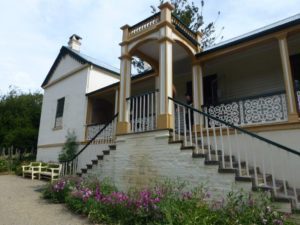
The Commandant’s House, Port Arthur
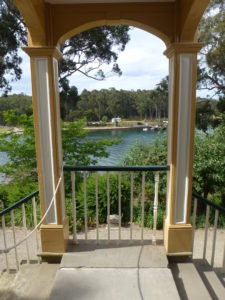
View from the Commandant’s House
The bright green pastoral setting is completed by pink and purple wildflowers that reach for light in between the giant sandstone buildings built by convict hands. One look from behind the barred windows provides one with a very different perspective of life at Port Arthur.
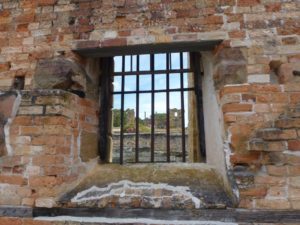
View from the inside of a convict building at Port Arthur
Port Arthur housed the harshest of the transported criminals, those who re-offended after being brought to Australia. Initially punishment focused on physical labor and corporal punishment. Convicts worked at gathering lumber, shipbuilding, and shoe-making. When they behaved well, they were afforded small luxuries as a method of positive reinforcement. If they didn’t, life became a living hell. All in the name of reform, of course.
After roughly fifteen years of the same practices, the British government decided to experiment. Wouldn’t punishing the mind be more effective than punishing the body? If prisoners were left no way of escaping the reflection of their heinous crimes, wouldn’t the result obviously be a reformed man? A distant cousin of the model being implemented in London at the same time, Port Arthur built a “Separate Prison.” Offenders in this model were kept in complete silence at all times. They worked and slept in their cells, receiving only one hour outside every three days.
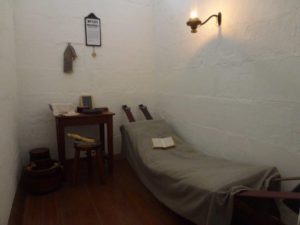
Inside the cells of the Separate Prison in Port Arthur
Upon leaving the cell, prisoners were hooded to prevent recognition and communication with fellow inmates. Men were identified only by numbers on their uniforms. One step out of line brought another level of misery. The “dark cell” was a form of solitary confinement where inmates could be detained for up to thirty days. Voices could be used only in the chapel–to sing hymns.
I wasn’t surprised that as a result of this experiment, the Lunatic Asylum on the grounds had to be expanded. Men were also known to commit murder to escape this hopeless existence in which the prison was the whole world and not merely four walls.
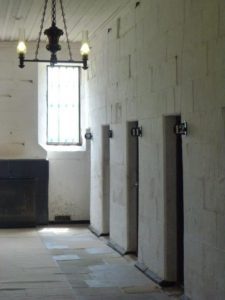
Cells of the Separate Prison, Port Arthur
In 1877, the prison closed and Port Arthur’s buildings sat empty for decades. Tasmanians were (understandably) not interested in reviving the dark past of the location, even changing the name of the town to Carnarvon before it reverted back to the original in 1927. Many people, myself included, are interested in man’s capacity for evil—no matter which side of the bars those men are on. Ghost stories persist about the surviving buildings that were saved from destruction and today the site is preserved by a historical society and managed by the parks service.
Even once a bistro and a boat ride were common highlights for visitors, there would be a last dark chapter for the people of Port Arthur. On April 28th, 1996, a man named Martin Bryant went on a shooting rampage in several buildings across the site’s grounds. He murdered thirty-five innocent people that day and injured dozens more. Bryant now resides in the psychiatric wing of Risdon Prison in Hobart serving thirty-five life sentences and 1035 years without parole. In the wake of the incident, the Australian government passed legislation to tighten the laws of ownership surrounding self-loading weapons. The incident remains the most devastating gun massacre in Australian history.
Though convict history was not initially embraced by Australians, it is now preserved as a crucial period of the evolution of Australia. Many of the men who were transported here went on to become free settlers with the skills they acquired while incarcerated. These are the first Australians in modern history and today having one of them in your family history is more fashionable than disgraceful. There is no disputing that the British convicts were not the first humans to live on what is now Australian soil, but it is their legacy that built an industrialized society. There is no doubt that it is the end result that will be remembered by historians, not the steps taken to get here.
The post The Secrets of Port Arthur appeared first on Worldwise Publications.



